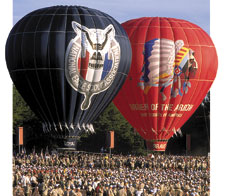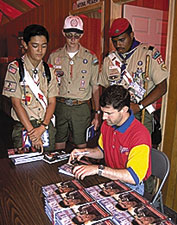![]() September 2000
September 2000

By Jon C. Halter
Photographs form BSA archives
 The sight of hot-air balloons hovering near the arena area is one that Scouts will always recall from the 1997 jamboree. |
Sardine sandwiches for lunch on the day of arrival
Those are some things I recall from the 1957 National Scout Jamboree at Valley Forge, Pa. They are also typical of the kind of special memories that 30,000 Scouts will take home next summer from the 2001 National Scout Jamboree at Virginia's Fort A.P. Hill, scheduled for July 23 to Aug. 1.
The first national Scout jamboree of the 21st century will be the highlight Scouting experience for most participants, just as the previous 14 jamborees were for the 600,000 Scouts who have attended them. A unique atmosphere sets each of these quadrennial national gatherings apart from other Scouting experiences. Every Scout feels special to be a part of such an extraordinary encampment, the importance of which traditionally includes a welcoming address from the President of the United States.
The distinctive location and sightseeing done on the way to, and home from, the site add to the special memories of participants. For many Scouts from western states, traveling to Washington, D.C. (1937), Valley Forge (1950, 1957, 1964), western Pennsylvania (1973, 1977), and (since 1981) Fort A.P. Hill was a first chance to see some of the nation's best-known landmarks. Jamborees in California (1953), Colorado (1960), and Idaho (1969, 1973) provided many Scouts from the East with their first trip beyond the Mississippi River.
In addition to location, jamboree memories are often closely related to the event's moment in time.
For example, Scouting magazine Executive Editor Scott Daniels and contributing writer Will Woodard attended the 1969 National Scout Jamboree at Idaho's Farragut State Park. Both recall listening to the live greeting the crew of the Apollo 11 lunar mission sent to the jamboree and then, several days later, watching on a small black-and-white TV as astronaut (and Eagle Scout) Neil Armstrong stepped onto the moon's surface.
Weather conditions can also create special, if not always pleasant, memories.
The site of the 1977 jamboree, Moraine State Park in western Pennsylvania, is not-so-fondly remembered by participants as "More Rain" State Park. Some 3.89 inches of rain fell when the ninth national jamboree was held there between Aug. 3 and 9.
Celebrity visitors, from entertainment or politics, hold favored spots in many personal jamboree memory banks. Ken Humphreys, a veteran Scouter from Memphis, Tenn., attended the first national Scout jamboree in 1937 and vividly remembered "seeing many of the national and world Scout leaders and also national leaders such as President Franklin D. Roosevelt."
 In 1997, Scouts got to meet pilot Scott O'Grady, a hero of peacekeeping in Bosnia. |
Scouts at the national jamboree at Valley Forge in 1950 received a double treat: speeches from both President Harry S. Truman and retired general Dwight D. Eisenhower (at the time famous only as a World War II hero).
Denver Scouter Frank A. Lawrence III, a leader of a Louisiana troop at the 1950 jamboree, recalled how the audience of 50,000 Scouts turned quiet when President Truman complained that their flashbulb picture-taking interfered with his ability to read his speech. "The next evening, General Eisenhower quickly advised the Scouts they could take all the pictures they wanted," Lawrence remembered. "The hills of Valley Forge erupted with loud, no, thunderous applause."
My 1957 memories include the moment when Vice President Richard M. Nixon was introduced as President Nixon; this prompted nervous murmuring throughout the audience until the Vice President good-naturedly acknowledged that he was only substituting for, not replacing, President Eisenhower, who was ill.
Show business stars of every magnitude have dotted jamboree marquees. Executive Editor Scott Daniels recalls that jamboree entertainment in 1969 featured Up With People, a clean-cut group of young singers known for feel-good tunes and lyrics. The dual locations in 1973 featured comedians Bob Hope (west) and Danny Thomas (east). And Scouts attending one of the five jamborees at Fort A.P. Hill beginning with the one in 1981 got to see music superstars like Lee Greenwood, Louise Mandrell, and the Oak Ridge Boys.
Scouting celebrities are also abundant at jamborees. Frank A. Lawrence III never forgot the surprise ceremony at the 1937 jamboree when he received his Eagle Scout Award from 87-year-old Daniel Carter (Uncle Dan) Beard, one of the BSA's founders. In 1964, the Scouts at Valley Forge met Lady Baden-Powell, widow of the founder of worldwide Scouting. And since the 1950s, Scouts have been able to personally meet Pedro, the Boys' Life "mailburro."
Transportation provides many remembered incidents. Scouts from the 1937 jamboree tell of long cross-country train rides, with hot cinders hitting their faces as they sat next to open passenger car windows. In the 1950s, many contingents arrived by bus—although most didn't have to stop en route to replenish an overheating radiator with water from a roadside stream, as our troop from the then-Jefferson-Lewis Council in northern New York State did.
Today, while troops still arrive by bus, many from farther away fly to a city like New York, Philadelphia, or Boston and continue their journey in rented vehicles or a chartered bus.
Jamboree activities provide a limitless source of memorable experiences. Scoutcraft and other camping skills have always been a part of the program, but each jamboree adds special events that incorporate the latest technological innovations.
The Merit Badge Midway alone provides opportunities to get expert help in passing all or most requirements for more than 60 merit badges.
Jamboree menus can inspire lots of personal memories, both good and bad. And the rate of food consumption always provides great publicity quotes, like the "17 miles of frankfurters" we gobbled down in 1957.
Next summer, unlike Valley Forge, there will be no sardine sandwiches for lunch on departure day. In fact, there may be no lunch at all, but rather a "big brunch" served for council contingents to consume as they break camp and prepare to head home.
"Sardines from Maine," by the way, remained a menu item for at least four more jamborees after 1957. Today, the containers are a much-sought-after piece of Scout memorabilia. Recent price guides indicate that collectors have paid as much as $25 for an unopened can from 1957 and 1960, and more than $10 for empty cans from 1969 and 1973.
What items from the 2001 jamboree will be on the most-wanted lists of memorabilia collectors? Whatever the answer, none can ever be more valuable to their owners than the treasured personal memories of each jamboree participant.
Jon C. Halter is the editor of Scouting magazine.
Fort A.P. Hill is the ideal site for BSA jamboreesIn the Spring 2000 issue of Now & Then, the BSA publication for retired professional Scouters, National Jamboree Director Donald R. Wilson recounted how Fort A.P. Hill became the permanent site of BSA jamborees:
|
| The Boy Scouts of America | http://www.scouting.org |